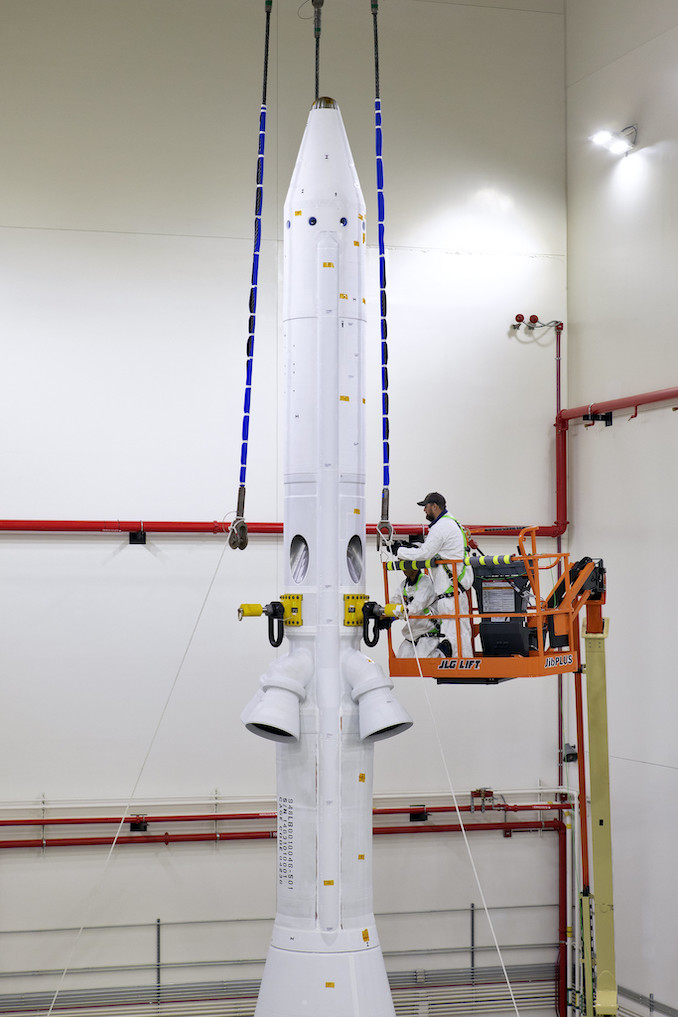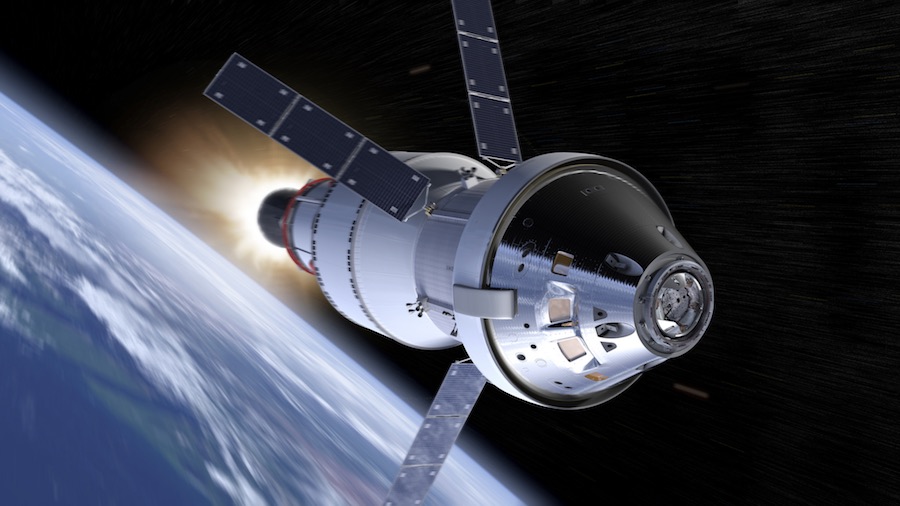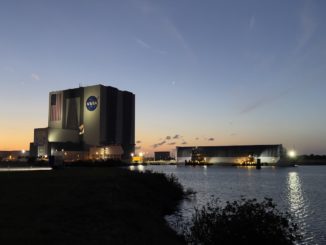
A three-minute test flight Tuesday morning over Cape Canaveral will help ensure NASA’s Orion crew capsule — the vehicle being built to carry astronauts back to the moon — can safely escape from a catastrophic failure on launch.
The $256 million atmospheric test flight, named Orion Ascent Abort-2, is designed to demonstrate the spacecraft can get away from a rocket in flight, a key safety feature that would save the astronauts inside the capsule in the event of a launch failure.
On future missions with astronauts, the Orion spacecraft will lift off aboard NASA’s Space Launch System, a huge 322-foot-tall (98-meter) rocket that will propel crews toward the moon. Tuesday’s test flight will use a much smaller rocket that will barely exceed the typical cruising altitude of a commercial airliner.
“It’s a three-minute flight test, but it’s really the only full-scale system test that we have before we put crew on the vehicle, so it’s definitely critical for making sure that we can get the crew safely away in an emergency,” said Jenny Devolites, the Orion AA-2 test director from NASA’s Johnson Space Center in Houston.
A boilerplate Orion capsule is set for launch during a four-hour window opening at 7 a.m. EDT (1100 GMT) Tuesday from Space Launch Complex 46, a seaside facility located near the easternmost point of Cape Canaveral Air Force Station in Florida.
The capsule will launch aboard a single-stage solid-fueled booster taken from the U.S. Air Force’s stockpiles of decommissioned Peacekeeper missiles, which were developed to deliver nuclear warheads to distant targets.
The ascent abort test comes after a series of ground test-firings of the Orion abort system, and a flight test conducted in May 2010 to simulate an escape from an explosion on the launch pad.
The pad abort in 2010 flew with a prototype abort system. The ascent abort Tuesday will test a fully functioning abort apparatus, the same configuration to be relied upon by astronauts.
“This test is extremely important,” said Mark Kirasich, NASA’s Orion program manager. “In Orion, crew safety and spacecraft reliability are very high priorities for us, and our launch abort system is a key safety feature of the spacecraft. It will protect the crew members who fly on-board Orion. It will protect them during the most challenging part of the mission, which is the ascent phase.”
No astronauts will be on-board for Tuesday’s flight, but veteran space flier Randy Bresnik said Monday he is eager to see the results of the abort test.
“It’s certainly a very exciting test for us tomorrow,” Bresnik said. “It is so important because it’s the only one of its type in the dynamic flight environment, the environment where it’s going to be needed most.”
On a real space mission, the Orion spacecraft would command an abort automatically if sensors detected a malfunction in the launch vehicle. Astronauts riding on the spacecraft will also be able to manually initiate an abort, Bresnik said.
The emergency landing of Russian cosmonaut Alexey Ovchinin and NASA flight engineer Nick Hague after a failed Soyuz rocket launch in October 2018 illustrated the importance of a launch abort capability, Bresnik said.
“We have to prepare for this, even though it’s a low likelihood of happening,” Bresnik said. “It had been 35 years since anyone on the planet had to exercise their launch abort system (before the Soyuz abort last year).
“That was definitely a good message to all of us that this is serious stuff,” Bresnik said. “We need to be ready because it has ultimate consequences if it doesn’t (work).”
Ground crews at Cape Canaveral have stacked components for the AA-2 test flight at pad 46 since April, beginning with the raising of the surplus Peacekeeper missile booster provided by the Air Force. The Peacekeeper’s SR118 first stage will ignite with a half-million pounds of thrust and turn due east from pad 46 to climb into the atmosphere over the Atlantic Ocean.
Northrop Grumman Innovation Systems, formerly known as Orbital ATK, assembled the Orion test booster, adding avionics, sensors and an aerodynamic shell to the Peacekeeper stage. The same first stage is used by the Minotaur 4 satellite launcher, which is also assembled and launched by Northrop Grumman under contract to the Air Force.
Engineers installed ballast plates, a separation ring and a test model of the Orion capsule on top of the single-stage booster at pad 46, which was itself modified for the Orion abort test with the installation of two new lightning protection towers.
Before transferring the Orion vehicle to the launch pad, teams inside a processing facility at NASA’s Kennedy Space Center connect the capsule to its launch abort tower, a needle-shaped structure that extends above the spacecraft and contains three separate rocket motors, all fueled by pre-packed solid propellants.
Lockheed Martin, the Orion spacecraft’s prime contractor, oversees the development of the launch abort system.
The Orion capsule flying on the AA-2 test flight was fabricated at NASA’s Langley Research Center in Virginia, and outfitted with wiring, sensors and other equipment at the Johnson Space Center in Houston before shipment to the Kennedy Space Center in December.
Forecasters at the Air Force’s 45th Weather Squadron predict a 70 percent chance of acceptable weather during Tuesday’s four-launch launch window. The main concern is with clouds that could obscure the view of the test by optical tracking cameras, a requirement for engineers to examine the performance of the abort system in flight.
The complete test vehicle weighs around 310,000 pounds, or approximately 140 metric tons.
After ignition of the SR118 booster rocket, the 93-foot-tall (28-meter) test vehicle will head east and climb to 31,000 feet (about 9,500 meters).
“The booster is going to give us about 500,000 pounds of thrust at liftoff in order to get us up to the right test condition at 31,000 feet,” Devolites said. “We actually had to add over 100,000 pounds of ballast to it just to slow it down, because it’s pretty sporty.”
The booster’s guidance system will aim to reach a predetermined set of conditions, such as speed, aerodynamic pressure and angle of attack, before the Orion capsule’s flight computer triggers the abort command 55 seconds after liftoff, at velocity of about Mach 1.3, or 1.3 times the speed of sound.
The abort will occur moments before the booster exhausts it’s propellant and burns out.
“When we get up to about 31,000 feet, we’ve got tremendous aerodynamic pressure on the vehicle, and we get a signal from the booster that we’ve reached the (test) condition, and it tells our flight computer and our flight software to initiate the abort,” Devolites said.
The Orion spacecraft’s Northrop Grumman-built abort motor, fitted with four fixed nozzles, will instantly ignite to pull the spacecraft away from the rocket.

“At that time we actually ignite the abort motor, which is about 400,000 pounds of thrust,” Devolites said. “It pulls about seven Gs, and it also ignites the attitude control motor that provides the steering. It rotates the vehicle around, re-orients it, and puts the heat shield forward for descent.”
The attitude control motor, also supplied by Northrop Grumman, is located at the top of the abort tower and features eight variable-thrust nozzles placed at 45-degree angles around the structure, each with the ability to independently controlled. The Orion’s computer will sense the vehicle’s orientation during the abort and send commands to the attitude control motor to move the position of pintles inside each nozzle to adjust thrust and keep the vehicle properly pointed.
The abort motor will fire for about 5 seconds, providing an additional impulse for the vehicle to reach a top speed of about Mach 1.5, according to Blake Watters, principal engineer on the abort system at Lockheed Martin.
The attitude control motor will re-orient the vehicle at about 43,000 feet (13,100 meters), then the abort system will separate from the capsule to fall into the ocean.
The abort system’s jettison motor is the only part of the assembly that will be used on every mission. On a normal launch, the jettison motor will ignite to push the abort tower off the rocket once it is out of the atmosphere.
Built by Aerojet Rocketdyne, the jettison motor produces around 40,000 pounds of thrust and will be the last part of the abort system to be used on the AA-2 test flight as the vehicle reaches a peak altitude of around 44,000 feet (13,400 meters).
“In an actual abort scenario, parachutes would deploy that slow the spacecraft down for a water landing, and then the crew returns safely to land,” Devolites said. “But for our flight test, we’re skipping the parachutes since those are being tested separately.”
NASA said disposing of the Orion test capsule, which is not designed to fly in space, makes the test flight less expensive and saved development time.
Twelve data recorders will release from the Orion capsule to fall into the Atlantic Ocean, where boats will be on standby to retrieve them for analysis. Nearly 900 temperature, acoustic and pressure sensors are flying on the test vehicle to record information in flight.

“We have two separate pods, they’re actually military flare dispensers, and they had six recorders in each one, and we eject them in pairs every 10 seconds,” said Don Reed, launch director for the AA-2 mission, in an interview with Spaceflight Now. “So 20 seconds after the LAS (launch abort system) jettisons from the crew module, we start ejecting, so the first pair comes out 20 seconds after the LAS is jettisoned, and then every 10 seconds until all 12 are ejected.”
The capsule is expected to tumble after the abort system jettisons, and it will impact the sea at 300 mph (480 kilometers per hour) around 7 miles (11 kilometers) offshore, and is designed to sink to the ocean floor, according to Reed.
The data recorders provide a backup to telemetry data transmitted back to the ground by the vehicle in flight. In the event ground teams to not receive telemetry data in flight, NASA only needs to recover one of the data recorders. Reed said retrieved all of the devices during a rehearsal last year.
Each recorder has a GPS locator beacon.
A NASA WB-57 jet will also be flying over Cape Canaveral to record optical tracking imagery during the Orion abort test, officials said.
The Orion abort system is similar in appearance to the escape system flown on the Saturn 5 rocket during the Apollo program some 50 years ago. One major difference is the Orion abort system has a maneuverable attitude control motor to fully govern the vehicle’s trajectory after an abort, while the Apollo spacecraft had a non-vectoring “pitch” motor to send the capsule in one direction during a launch escape event.
The upgrade gives the Orion spacecraft the ability to escape from its launcher under more extreme conditions than possible with Apollo.
Space shuttle crews had no ability to use an abort rocket to escape a catastrophic failure during launch.
The new commercial crew capsules developed by Boeing and SpaceX to ferry astronauts to the International Space Station both have “pusher” escape systems, employing liquid-fueled rocket engines along the rear circumference of the vehicles to propel astronauts away from a launcher in an emergency.
The Apollo, Soyuz and Orion designs utilize “puller” abort systems.
NASA selected Lockheed Martin to begin developing the Orion spacecraft in 2006 under the auspices of the space agency’s now-defunct Constellation program, which started under the George W. Bush administration in the aftermath of the loss of the shuttle Columbia and its seven-person crew in 2003.
After the Columbia accident, the Bush White House directed NASA to end the shuttle program after completing the International Space Station, allowing the agency to re-focus on deep space exploration, with an objective of returning humans to the moon’s surface by 2020.
But the Constellation program ran into numerous delays and cost estimates crew, prompting President Obama to cancel the program in 2010. A year later, the White House and Congress agreed on a new strategy for NASA, salvaging work already completed on the Orion program and kicking off development of a new rocket called the Space Launch System for eventual missions to Mars.
The Orion and Space Launch System programs have encountered more difficulties since 2011, delaying the first launch of an unpiloted version of the crew capsule on the SLS from 2017 until no earlier than late 2020, or more likely some time in 2021.
NASA and Lockheed Martin conducted an Orion test flight in Earth orbit in December 2014 to test the capsule’s heat shield at the speeds it will encounter on re-entry from the moon. Engineers also conducted the Orion pad abort test in 2010 and a series of parachute drop tests.

NASA has spent around $16 billion on the Orion program since its start, according to Laura Forczyk, a space policy analyst. The SLS program has cost around $14 billion to date, she said earlier this year.
The Orion and SLS programs form the core of NASA’s newly-announced Artemis program, which will attempt to land astronauts on the moon by 2024, responding to a directive from the Trump administration.
The first SLS/Orion mission, now designated Artemis 1, will send the Orion spacecraft on a flight lasting at least 25 days in a distant orbit around the moon, then back to Earth. Lockheed Martin engineers at the Kennedy Space Center are readying the Orion capsule for Artemis 1, along with its European-built power and propulsion module.
The Artemis 2 mission, currently set for launch in 2022 or 2023, will be the first Orion flight around the moon with astronauts.
In the meantime, NASA and commercial partners will build and launch elements of the Gateway, a mini-space station in lunar orbit that will be a stopover and safe haven for astronauts on the way to the moon’s surface.
NASA’s planned flight sequence would make the Artemis 3 mission the first opportunity to conduct a lunar landing with astronauts in 2024. But the schedule assumes no more delays and full funding of the moon landing initiative by Congress, which NASA Administrator Jim Bridenstine told CNN last month will cost some $20 billion to $30 billion over the next five years, on top of the agency’s previously-planned budget.
Email the author.
Follow Stephen Clark on Twitter: @StephenClark1.



